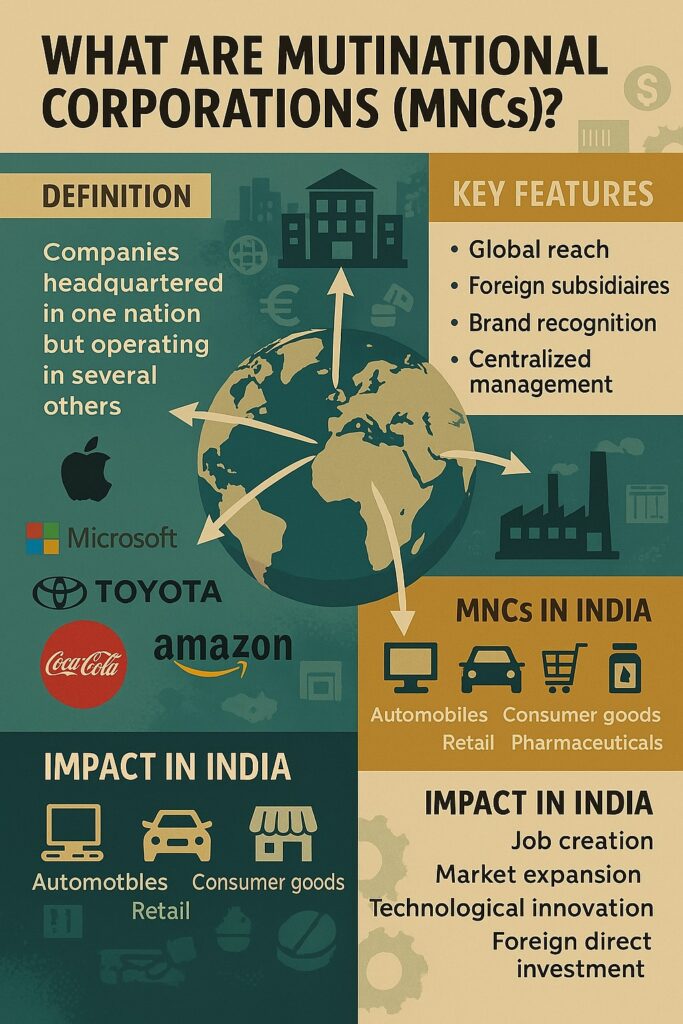The economic transformation of India since the 1990s has been significantly shaped by the twin forces of liberalisation and the entry of multinational corporations (MNCs). These developments have played a crucial role in the reorganisation of industrial activities, employment patterns, and urbanisation across the country.

Table of Contents
1. What are Multinational Corporations (MNCs)?
Multinational Corporations (MNCs) are companies that have business operations in more than one country. They are usually headquartered in one nation but own or control production and services in multiple countries. In the Indian context, MNCs have become key players in sectors like information technology, automobiles, consumer goods, retail, and pharmaceuticals.
Examples in India:
- Google, Microsoft, Amazon – IT and e-commerce
- Toyota, Hyundai, Honda – Automobile industry
- Nestlé, Unilever, PepsiCo – Food and beverages
- Samsung, LG, Apple – Electronics and mobile phones
2. What is Liberalisation?
Liberalisation in India began in 1991 as part of a series of economic reforms to overcome a major financial crisis. The government adopted a policy shift from a tightly controlled economy to a more open and market-driven one.
Major Steps Taken:
- Ended industrial licensing for most industries
- Reduced import tariffs and quotas
- Encouraged Foreign Direct Investment (FDI)
- Allowed private sector participation in many sectors
- Reduced the role of public sector undertakings (PSUs)
3. Impact of Liberalisation on Indian Economy
The liberalisation policy led to rapid growth in several industries and attracted significant investments from MNCs. India became an important destination for global capital, outsourcing, and manufacturing.
Positive Outcomes:
- Rapid growth of the IT and service sector, especially in cities like Bengaluru, Hyderabad, and Pune
- Increase in employment opportunities, particularly for skilled workers
- Improved access to modern goods, technologies, and services
- Growth of infrastructure and real estate, especially in metropolitan cities
- Boost to exports in software, textiles, pharmaceuticals, and auto parts
Challenges:
- Widening gap between urban and rural areas
- Pressure on small-scale and traditional industries due to competition
- Rise in urban congestion and pollution
- Increased dependence on foreign companies for technology and capital
4. Geographical Impact of MNCs in India
Multinational companies have played a key role in reshaping India’s economic geography. Their presence has led to the growth of industrial clusters and modern urban centres.
Examples:
- Bengaluru – Global IT and innovation hub
- Gurugram and Noida – Centres for BPOs, software, and corporate services
- Chennai and Pune – Automobile and engineering hubs
- Hyderabad – Emerging pharmaceutical and biotechnology hub
However, the benefits of MNCs have been unevenly distributed. Most investments are concentrated in a few states like Maharashtra, Tamil Nadu, Karnataka, Telangana, and Gujarat, while other regions like Bihar, Odisha, and North-East India lag behind.
5. Role in India’s Global Integration
With the rise of MNCs and liberal economic policies, India has become a part of the global value chain (GVC). Indian companies now collaborate with foreign firms in areas such as software development, automobile parts manufacturing, and pharmaceuticals.
Conclusion
Multinationals and liberalisation have transformed India’s economic structure, bringing growth, innovation, and global connectivity. However, the challenge lies in ensuring that this growth is inclusive, regionally balanced, and environmentally sustainable. Strategic planning, investment in education and infrastructure, and support for small enterprises are essential to make liberalisation truly beneficial for all sections of Indian society.
Read: Geography Notes